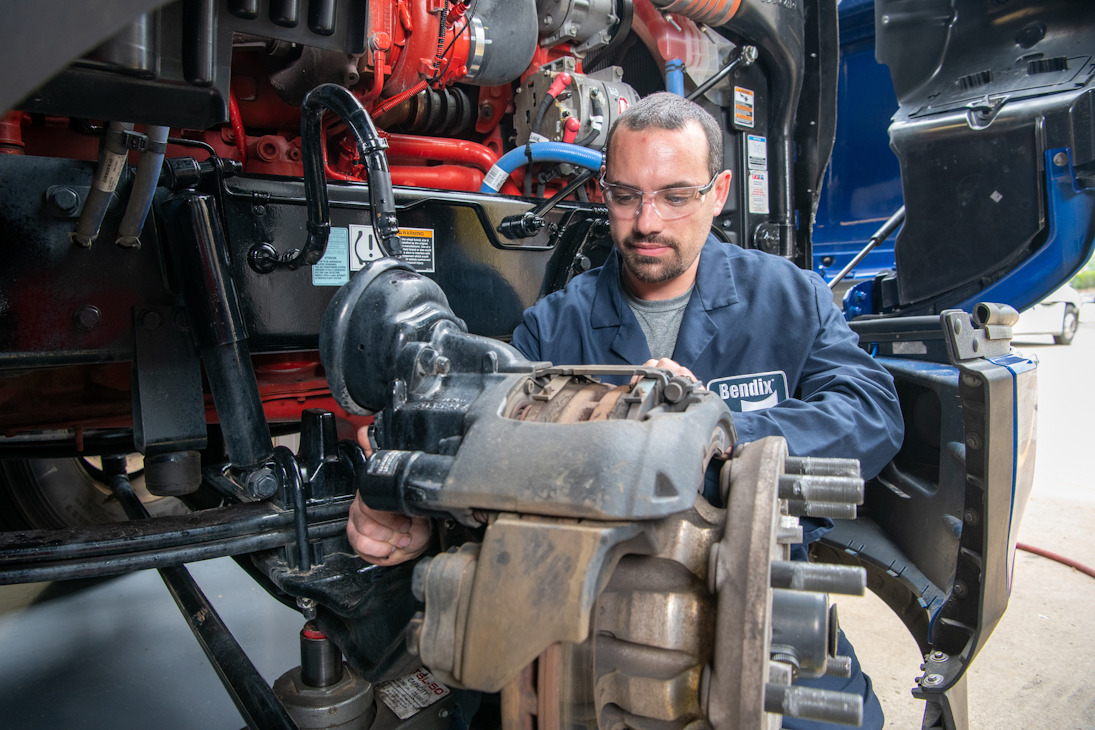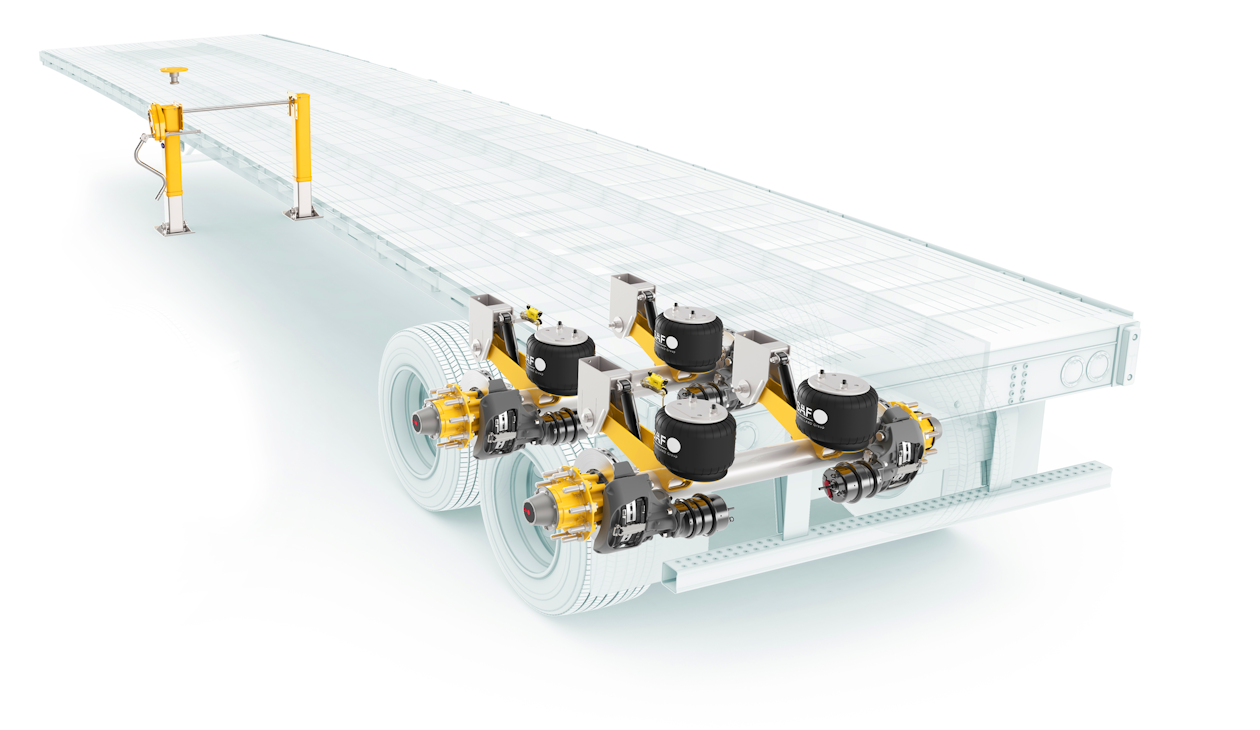Balancing air disc brakes and drum brakes is no easy task, but doing so can pay dividends in optimal safety and efficiency.
As with any new vehicle system, the advent of air disc brakes (ADBs) changed maintenance requirements and vehicle configurations considerably for Class 8 tractor-trailer fleets. ADBs are becoming an increasingly common spec on Class 8 tractors in North America. However, most trailers, which are older than tractors, are still spec’d with drum brakes.
This difference in braking systems between the two pieces of equipment creates added service challenges for fleets because air disc and drum brakes have very different operating parameters that must be “balanced” in order to ensure optimal safety and efficiency on a tractor trailer. Unfortunately, doing so is a time-consuming process. As a result, many fleets elect not to balance brakes. However, fleets that do take the time and effort are rewarded with safer vehicles, longer brake life, and fewer associated maintenance issues.
“The trucking industry’s growing preference for air disc brakes versus conventional drum brakes is evident in the increasing adoption rates on both tractors and trailers,” noted Joe Kay, director, engineering, front drivetrain, Meritor. “Currently, we see the Class 8 market share of air disc brakes around 45% for tractors and around 15% for trailers. We anticipate that ADBs will account for more than 60% of the overall brake market by 2025.”
Although the adoption rate is lower, Kay added the steady ADB growth in tractors is also driving adoption in the trailer market.
“As fleets feel more comfortable with product knowledge and get to experience the benefits of ADBs on tractors, we believe trailers will follow at a faster pace than what we have seen in the past few years, potentially growing to a 40% adoption within the next decade,” he said.
Stopping power differences
The essential issue in running both types of brakes on tractor-trailers is that ADBs behave differently in that they can stop a combination vehicle in a shorter distance that drum brakes, said Keith McComsey, product group director, air disc brake systems for Bendix.
“ADBs maintain that stopping power more consistently throughout larger temperature ranges,” McComsey explained. “Drum brakes are not able to maintain consistent stopping power because of brake fade—a phenomenon where the drum heats up from repeated brake applications representative in stop-and-go traffic, downhill descents, and/or repeated higher-pressure brake applies. Then, as the brake drum absorbs more and more thermal energy, it expands away from the brake friction. ADBs do not display this condition, since brake rotors dissipate heat more efficiently and/or when they do heat up, they expand toward the friction rather than away.”
The upshot here, McComsey said, is that maintenance managers need to understand that replacing the original friction with non-OEM friction can lead to different performance, including increased stopping distances, reduced pad wear life, accelerated rotor wear, and other issues. These changes in brake performance will then be experienced by drivers who had grown accustomed to the vehicle’s original stopping performance.
Risks of unbalanced brakes
“Brake balancing includes, but is not limited to, the even brake force generation within a vehicle axle combination or tractor-trailer combination—to ensure an equal and evenly distributed braking throughout the vehicle or combination,” said Dirk Wohltmann, director of engineering, Americas, Commercial Vehicle, ZF Group. He noted that maintenance managers should also consider other factors when running both brake types, such as the equal apply-and-release timing and pressure balance (axle-to-axle or vehicle combination), as well as the hysteresis between brake apply and release.
“At the end,” Wohltmann said, “there should be an evenly balanced brake torque throughout all involved braked axles (including trailer) in all possible braking situations: snub braking with low brake force, up to emergency braking with full torque in extreme short apply times, as well as reducing braking activity (release but hold brake). An evenly distributed brake force and timing behavior is important for comfortable vehicle driving, best braking performance, vehicle stability, even brake wear, and to prevent brake damage due to overload of individual brakes.”
And, Wohltmann added, fleets should also consider the safety risks that can arise from unbalanced brake systems.
“Unbalanced brakes may lead to uneven brake wear and temperature impact, early fade out of the drum brake with the full brake performance transferred to the remaining brakes (mostly the ADB) which would lead to lower overall stopping performance,” he said. “Other risk factors include overheating and disc rotor crack damage in ADB that could affect vehicle driving comfort and instability.”
According to Wohltmann, drivers can tell if a combination brake system is out of balance by looking for these problems:
- Early heat related brake fade-out
- Trailer push or tractor over-braking (instability tendency)
- Individual brake overheating
- Uneven brake pad wear
Likewise, he noted, maintenance professionals can look for telltale issues such as:
- Uneven brake pad wear
- Overheat damage to ADB or surrounding area
- ADB disc rotor cracking
Optimal semi-trailer brake balance is a complicated mix of five factors, explained Tony Ryan, technical services and training manager for SAF-Holland. Those include mechanical brake force, pneumatic brake force, pneumatic balance between the truck and trailer, weight transference, and brake fade.
“Three of these factors are set before the driver takes off,” Ryan noted. “Weight transference can roughly be accounted for, but brake fade is the big unknown variable. If you don’t start with the first three correct, then you are fighting an uphill battle for safe braking of your vehicle.”
Ryan advised it takes extremely high temperatures—which drivers will never experience—to cause brake fade with air disc brakes. This is unlike drum brakes, which can more readily fade at much lower temperatures.
Brake balance maintenance considerations
Before deciding to begin a brake-balancing maintenance program, fleets first need to set some basic goals, said Randy Salvatora, manager, engineering systems at Bendix. He noted that “balancing” can mean different things to different people, and that at a fundamental level the ability of a brake to absorb and dissipate energy can be described as thermal balance.
“Drum brakes tend to fade and reduce their torque output as they heat up, while disc brakes provide a more consistent torque output across a wider temperature range,” he explained. “When disc brakes are combined with drum brakes, the disc brake will absorb additional energy that the drum brake is unable to (as a result of brake fade). This can lead to a perception of accelerated wear rates of the more effective [disc] brake, because the ADBs are carrying a larger share of the braking.”
The act of “balancing” brakes in a historical context meant a routine maintenance procedure of inspection, lubrication, and adjustment of the foundation brake hardware, Salvatora noted. “The initial pressure at which a brake starts to develop torque (described as the threshold pressure) is critical to a balanced brake system. This can be influenced by many factors, including design as well as maintenance.”
If an issue is suspected, Salvatora advised fleets reference the Bendix BW1555 brake balance procedure guidelines or the SAE J1505 Brake Force Distribution Test Procedure to quantify and measure brake threshold and pneumatic balance of the braking system.
At Meritor, Kay said, brake balancing refers to brakes equipped on an axle-to-axle configuration, adding that brakes are sized and specified by gross axle weight rating (GAWR) for commercial vehicles. Additionally, he said, FMVSS121 requirements will need to be met for commercial size vehicles using air brakes.
“All in all, it is important to remember that tractor and trailer brakes must always work as a system,” Kay stressed.
“Air disc brake and air drum brake balancing ensures that each brake is able to apply and release at the same time and is able to build torque to convert energy effectively,” he added. “The brakes need to work together when applied and we want each brake to contribute its proper amount of work—with ‘work’ defined as the amount of energy converted during the stop.”
Optimizing brake torque output for the tractor-trailer combination helps to avoid stability concerns like pushing, pulling, or jackknifing the vehicle, noted Kay.
“Universal brake compatibility for existing tractor-trailer combinations has been a desire for our entire industry for a long time,” Salvatora said. “And to that end, brake compatibility has been examined and refined during each incremental progression of commercial vehicle technology.”
He suggested fleets communicate with the vehicle manufacturer and the brake system manufacturer for guidance on servicing and troubleshooting brake system issues.
By James Alfred
Source: https://www.fleetmaintenance.com






